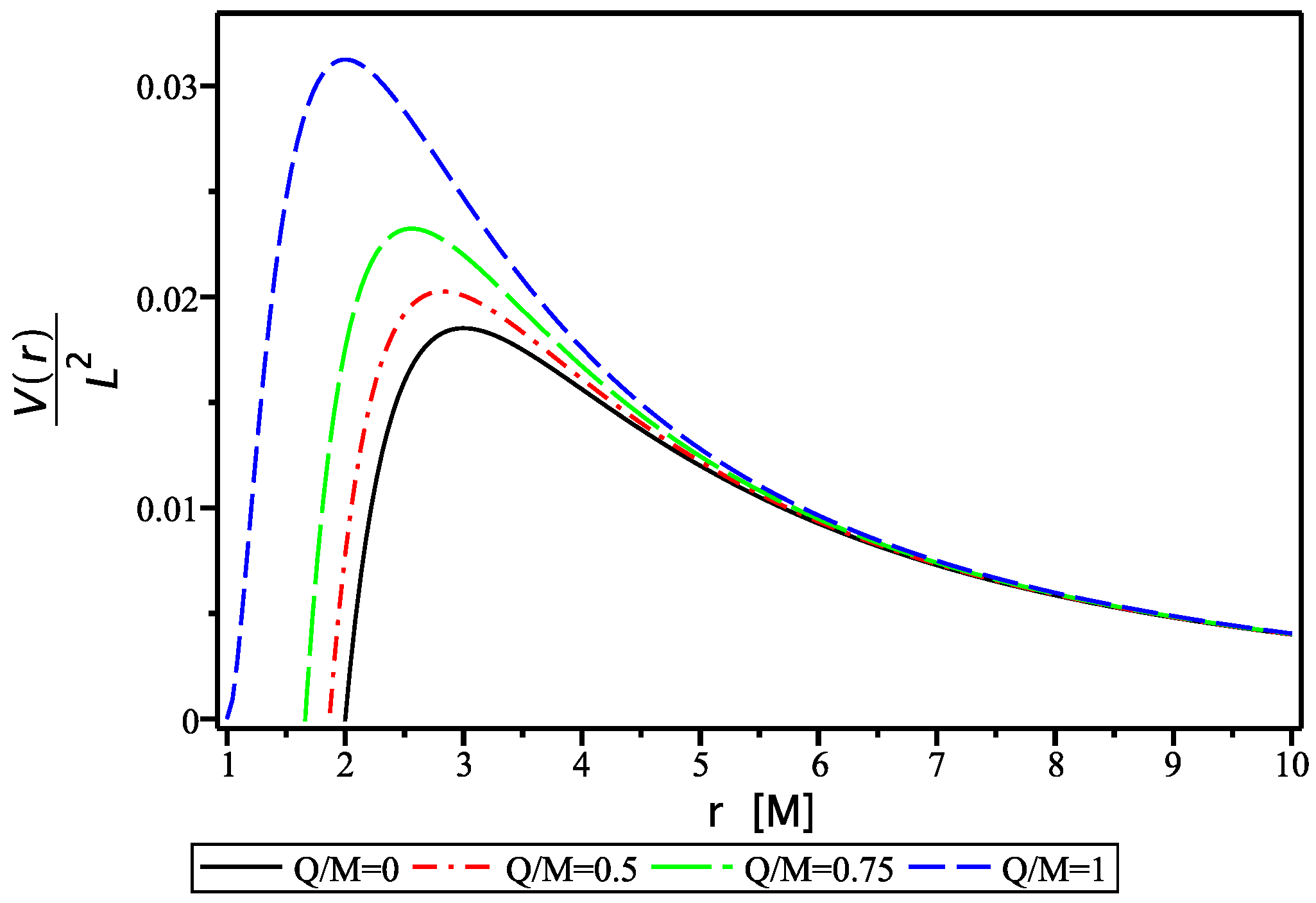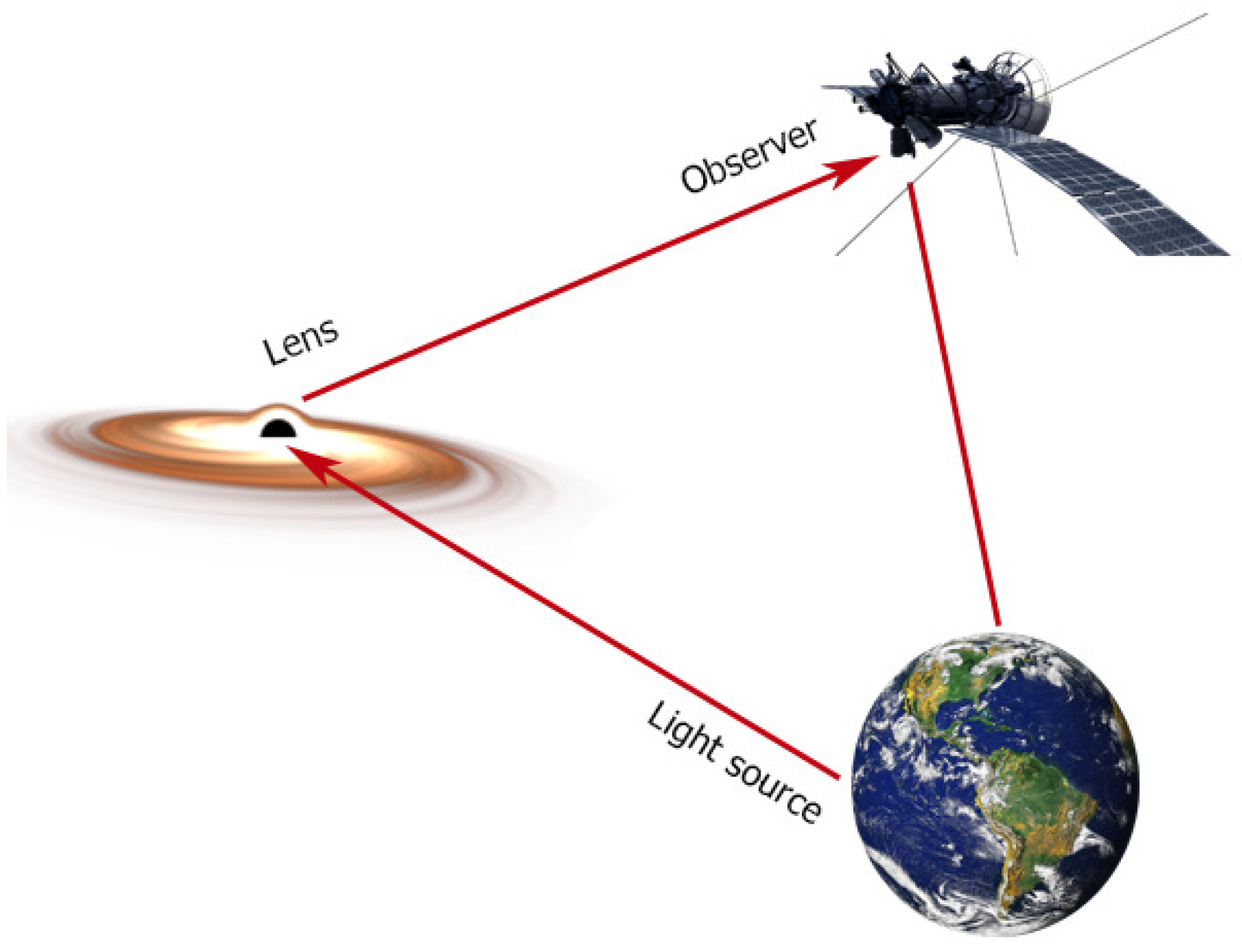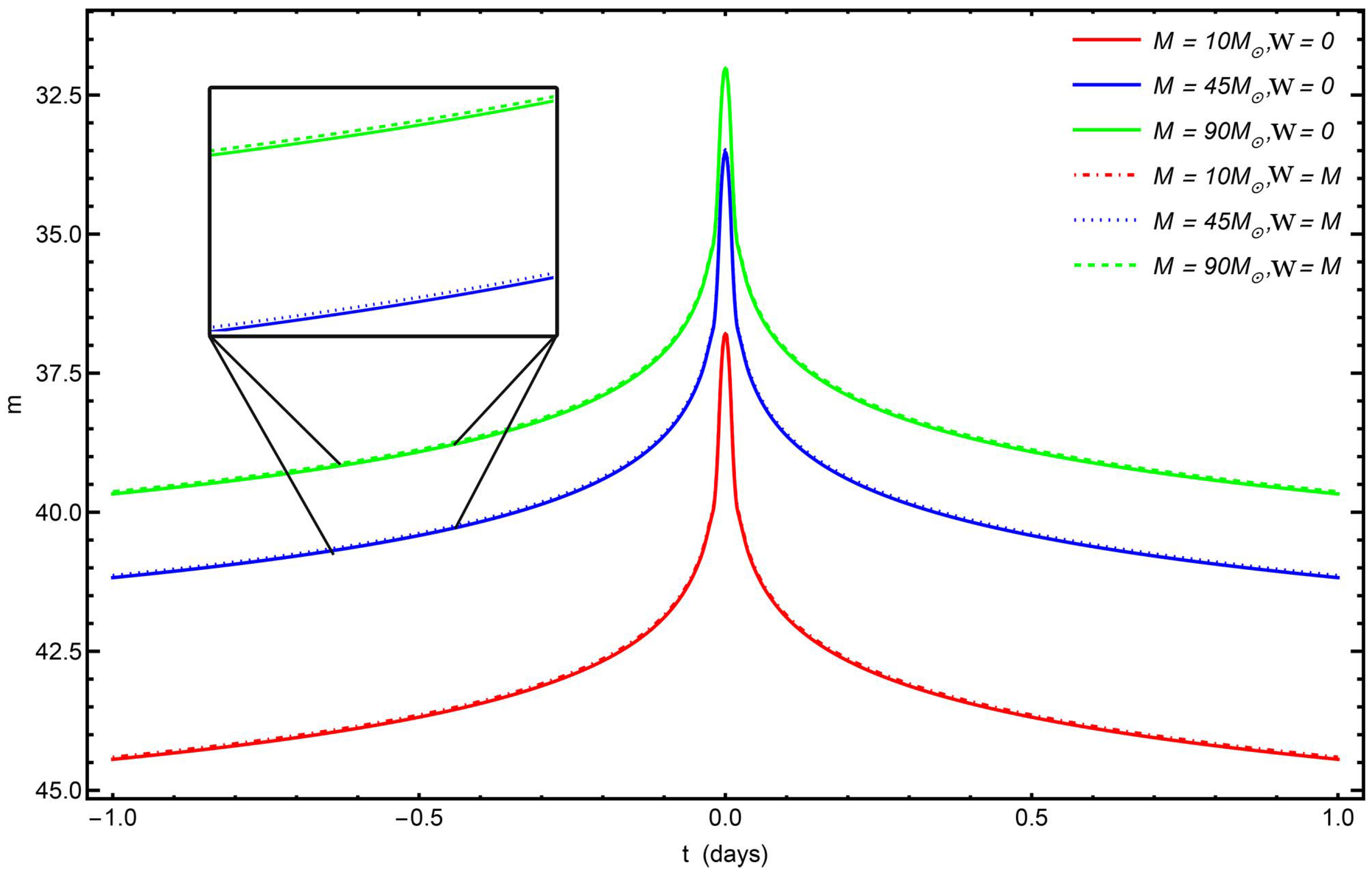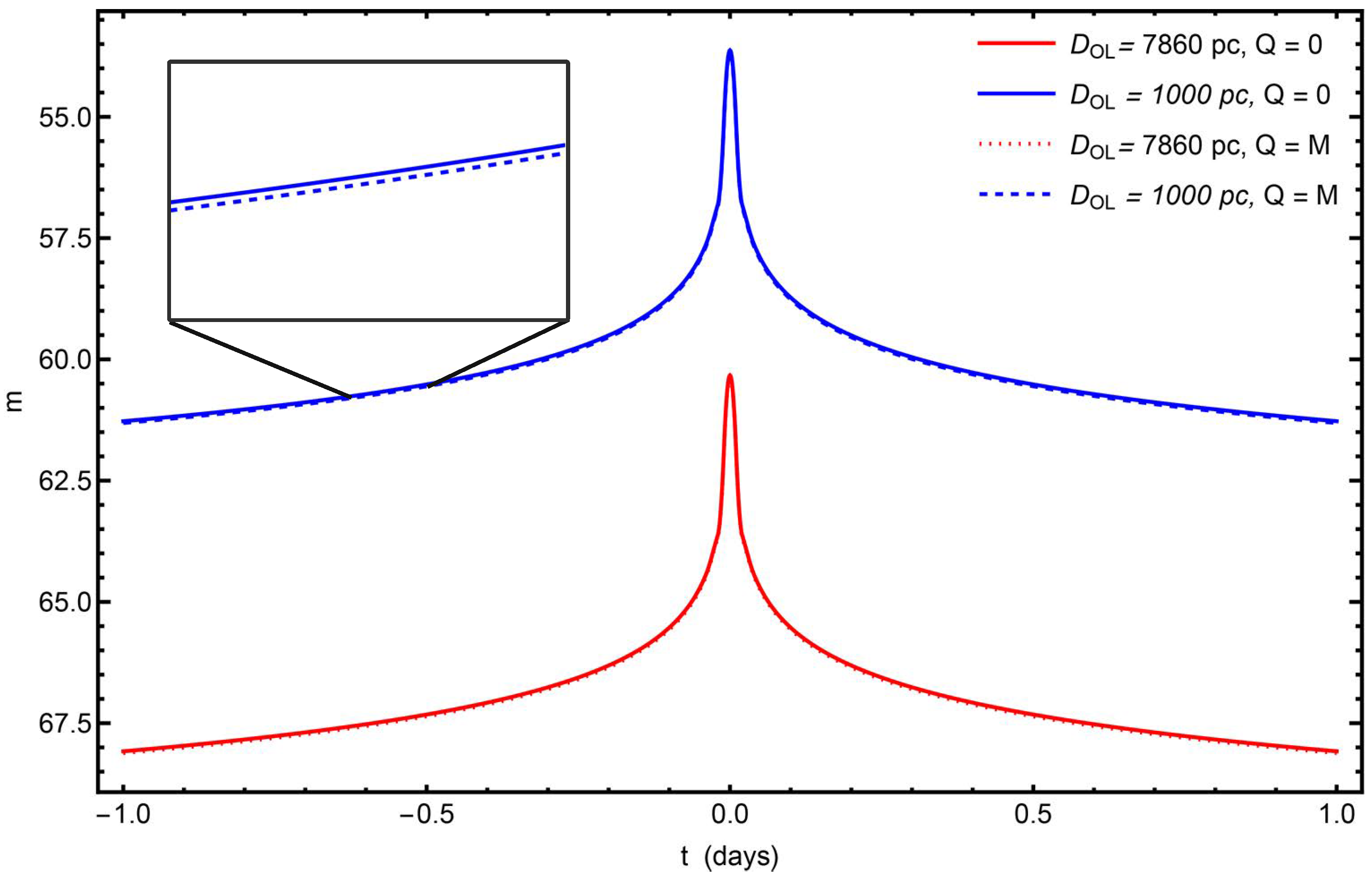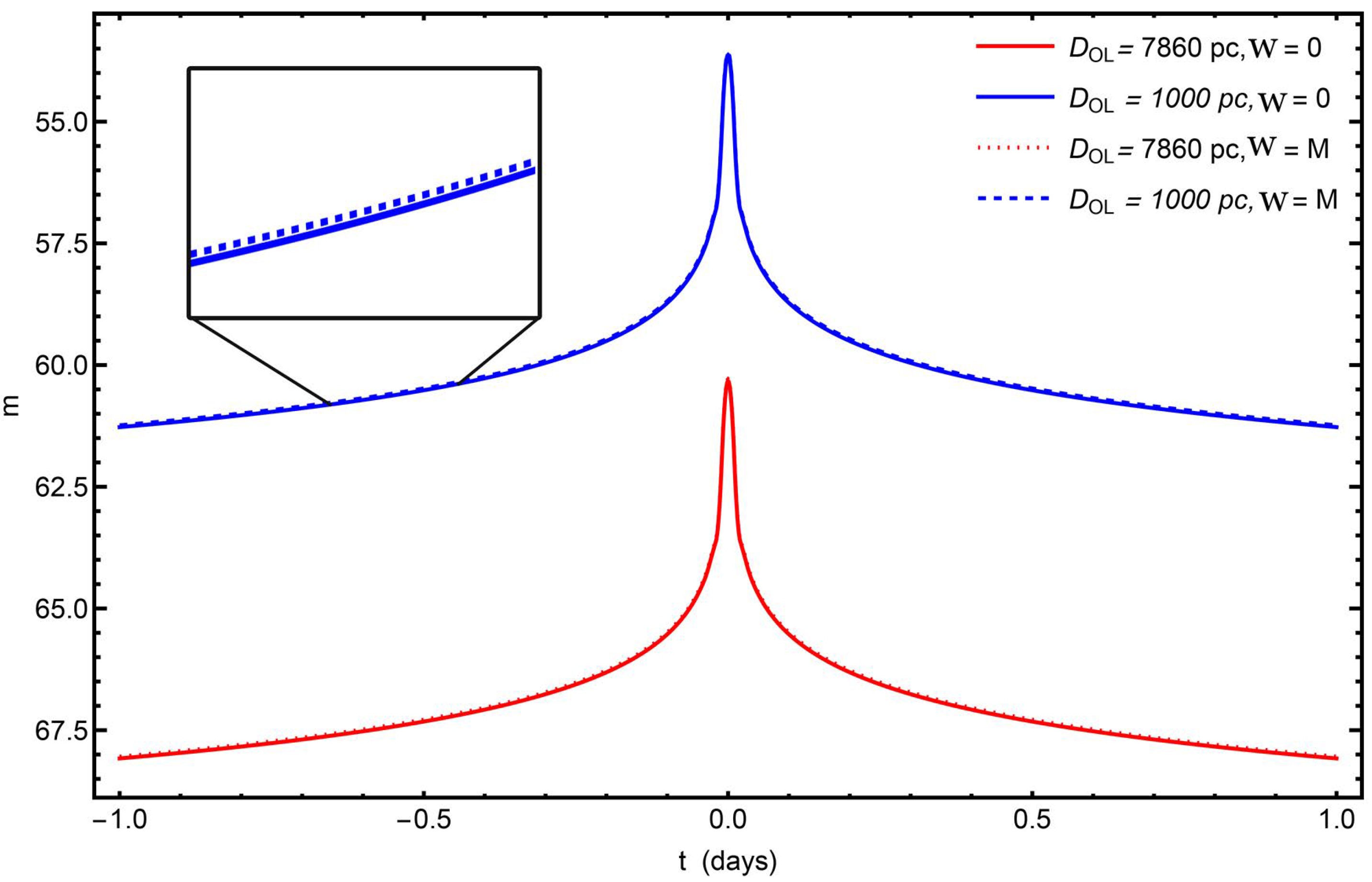1. Introduction
By observing the light of distant galaxies, we are seeing them as they were when the light left them millions or even billions of years ago. This provides the possibility that the light of these astronomical objects carries information about their structure in different eras of space–time. Spectral lines can be used to determine the value of physical quantities such as the angular speed and mass of the galaxy, and so on. The idea of looking back in time by observing the light emitted in the past deals with rays of light that travel from some minutes, such as the light that reaches us from the Sun to even billions of light-years, in the case of light coming from the most distant galaxies. The practical utility of this type of observation can be viewed, for example, in the detection of the light of distant galaxies that allows us to see what the universe was like billions of years ago.
On the other hand, general relativity (GR) tells us that the light emitted from these objects actually propagates in a curved path due to the distribution of energy and matter in the universe. Indeed, one of the first observational triumphs of GR was the correct description of the bending of light in the vicinity of the Sun with the weak-field consideration [
1]. Since then, the study of the gravitational lensing phenomena has been revisited several times [
2,
3,
4,
5,
6,
7,
8]. Compact objects such as black holes have a gravitational field so strong that light rays from the stars and galaxies can orbit the black hole several times before reaching a distant observer in space–time [
9,
10,
11]. In this context, the strong gravitational regime imposes intense effects on the structure of space–time, and the geodesic equations for the bending of light in this regime must be solved without a weak field approximation. Recently, the Event Horizon Telescope (EHT) collaboration made the first image of the M87* black hole, observing an intricate pattern of the paths of light around it [
12,
13,
14].
In this way, as in the case of the orbit of massive particles, photons can also circulate around a black hole [
15,
16]. For example, the region where
called the photon sphere, is the lower bound for stable orbits for the uncharged Schwarzschild black hole. At this place, the photon may either escape to infinity or fall into the black hole. Furthermore, there are additional regions in space–time where photons can be emitted and loop around the black hole, returning to the emission point depending on the emission angle of the photons and the distance of the black hole. Note that there is no length limit for the radius of the orbit for these boomerang photons; consequently, a ray of light from the Earth to the compact radio source Sgr A* can loop around the black hole and return to the solar system. In this case, when the photons return, they carry information about the rays of light emitted by a source 52,000 years ago.
A flash of light that returns to the emission point can also be used to determine the mass and the distance of a black hole through the apex angles associated with orbits obtained from the geodesic equation in Schwarzschild space–time [
10]. A pedagogical discussion on the uncharged Schwarzschild black hole can also be found in [
17]. This work discusses the trajectories of photons that circle around black holes. In [
11], the author extends the use of the static black hole as a gravitational mirror to the case of an uncharged Kerr black hole, giving a precise description of the concept of boomerang photons.
Due to the fact that compact objects can deflect the light ray paths to large bending angles, a particular type of gravitational lensing has been explored recently. Holz and Wheeler introduced the concept of retrolensing, where the observer may be between the source and the lens [
18]. In this work, the authors estimate the apparent magnitude of retrolensing events by considering black holes as lenses placed at the border of our solar system. The Sgr A* black hole at the galactic center as a retrolens for a star at a close distance was considered in [
19]. In this case, the results provide evidence that such an event could have high magnitude as a consequence of the vicinity of the star to the Sgr A* black hole. Other advances in retrolensing systems have been made in the following articles [
20,
21,
22,
23,
24,
25,
26]. In Ref. [
27], whose approach we closely follow, retrolensing is analyzed for the charged Reissner–Nordström black holes, while in Ref. [
24], the electric charge is replaced by the Weyl tidal charge, in the form
, which acts in consonance with the black hole mass, in a braneworld model. Thus, although retrolensing has been extensively studied in theoretical and numerical models, it remains an open problem in observational astrophysics.
The aim of this article is to present a study of trajectories of returning photons in a retrolensing geometry considering bodies in the solar system. As a particular system, Earth as a source in the retrolensing geometry is considered when we propose an apparatus to improve the magnification of the image. In this way, our focus is on the properties of the image of the source of photons in addition to the existing studies of retrolensing, where the goal is to determine the properties of the path of light around a source of the strong gravitational field. To this end, we structure the paper as follows: In
Section 2, we review the Reissner–Nordström space–time and discuss some basic aspects concerning the trajectories of particles in this geometry. In
Section 3, we study photon trajectories in a general static spherically symmetric space–time, and in
Section 4, we explore the trajectories of the photons that return to their emitter and find out the conditions for this type of motion. In
Section 5, we propose a scheme to address the lens geometry associated with the Earth as a source and an orbiting satellite as an observer in a retrolensing event. Finally, in
Section 6, we discuss our results.
3. Photon Trajectories in a General Static Spherically Symmetric Space–Time
An important physical quantity to the study of photon trajectories is the point where the potential associated with the photon trajectory
reaches an extremum
(the derivation of
can be found in
Appendix A). As can be seen in
Figure 1,
corresponds to the extremum values of the curves of the effective potential as a function of
r (in terms of
M). The solid line denotes the potential of a photon in the space–time of a non-charged black hole with
. In contrast, the dashed (blue) curve represents an extremal charged black hole with
. Thus, increasing values of charge moves
towards the Schwarzschild radius
. On the other hand, if the electric charge is replaced by the tidal (or Weyl) charge in a braneworld scenario, the behavior of the potential is reversed: as this charge increases, the potential barrier lowers. This suggests that the influence of the extra dimension facilitates the penetration of photons into the black hole’s interior.
After some algebra, Equation (
A4) can be written in the following way:
where
is the impact parameter of the photon. By integrating Equation (
4), the solution,
, describes the orbital motion of photons in terms of the constants of motion. In the closest approach, denoted by
, that satisfies
and
, Equation (
4) gives the relation
Another useful expression related to
is the critical impact parameter
, defined as
Indeed, the parameter
is directly associated with the strong deflection limit since, at this limit,
approaches
. With these quantities, the deflection angle
of the photon trajectory can be written in the following way [
27]:
where the integral
I is defined as twice the function
obtained of Equation (
4), i.e.,
Equation (
8), along with integral (
7), gives us the deflection angle in a general way. Due to the type of trajectories that we are interested in, they will be solved by considering the strong gravitational limit where
. In this regime, the solution can be written in the following way (see [
27] for more details):
up to higher-order terms in
, where the parameters
and
are given by
and
where
. In the uncharged case, corresponding to
, Equations (
10) and (
11) reduce to the well-known results
and
respectively [
27].
5. Black Holes as Gravitational Mirrors: A Possible Apparatus
In recent days, two geometries have been considered in the literature on gravitational lensing: the first one corresponds to a light source behind the black hole (standard geometry), while the second one (retrolensing) presents a source in front of the black hole. In
Figure 4, we illustrate the lensing configuration for a retrolensing geometry that we use in this work, where the Earth is represented as the light source for the retrolensing. The photons emitted reach the black hole, and then they return to the observer (satellite) near the Earth. Before we present the standard retrolensing configuration, we discuss observing strategies based on the population of stars that probably collapse to form black holes locally.
As explained before, we will use a compact object with a strong gravitational field such that the light circulates around
n times before returning to the emission place; the equations associated with this type of motion indicate massive objects as lens candidates. Thus, two categories of black holes can be analyzed in our retrolensing study: distant supermassive black holes and nearby stellar black holes. The supermassive black hole in Sgr A* with a mass of
[
28] is an example of a supermassive black hole that we analyze in the next section. The great mass of this object favors the amplification effect of the lens, but the big distance is a negative factor in this scenario. Another interesting aspect of this class of black holes is related to the age of the image observed. If the Earth is considered a light source in this retrolensing phenomenon, then we can see how Earth’s light was 52,000 years ago when Neanderthals lived on the Earth.
Despite the interesting implications of this scenario, this type of observation is very difficult with current technologies due to the distance from Sgr A* or another massive black hole. As a second possibility, we can consider nearby black holes. As discussed in [
18], theoretical estimates give a result for the local density of stellar black holes
circa , while the mass of these objects lies in the range
. The earliest population of stars with masses in the range
is another route to generate a retrolensing event since these stars probably collapse and form black holes with similar mass. At the moment, the nearest known black hole candidate is the object HR6819 (
), but it has not been confirmed yet [
29].
In this section, we discuss the framework used to deal with retrolensing in the Reissner–Nordström space–time following Ref. [
27]. Then, we consider the application of the obtained results to the original retrolensing problem proposed in this paper. To realize the idea illustrated in
Figure 4, we consider the retrolensing scheme in
Figure 5. As we can see, the parameters
,
, and
are the distances between the observer and the Earth, between the observer and the black hole, and between the black hole and the Earth, respectively. In addition, the angle
is the angular position of the image with respect to the position of the black hole,
is the angle formed between
and
, and
is the angle between
and the light ray (see
Figure 5). These angles are related by the Ohanian equation in the form [
30,
31]
By assuming that the lens, the observer, and the source are almost aligned and
, we can use the relations
and
. It follows from (
12) under the assumption of a strong deflection limit, neglecting small terms in
and
, the positive solution [
27]
where
. The magnification associated to the Equation (
13) is given by [
27]
where
for the case
, and
for the case
, where
, with
being the radius of the source. It is considered in Equation (
16) that the origin of the coordinates is on the intersection point between the source plane and the axis
. The negative solutions for
and
can be written by observing the relations
In this way, the total magnification
is obtained as the combination of these relations, the result is
These results have been applied in the study of retrolensing problems involving the Sun as the source. For example, by considering a black hole of at distance in the case of perfect alignment, we obtain the maximum amplification with a magnitude of , an observable value. In the next section, we apply these ideas, considering that the Earth moves on the source plane with the orbital velocity.
Retrolensing
Now, we investigate the retrolensing light curves by nearby black holes as proposed by [
18] with masses in the range (10–90)
considering the scheme proposed in
Figure 4 and
Figure 5. By inspection of Equation (
18), it can be seen that the parameters
and
M have played an important role in the final value for the magnitude of the images. In this first example, we consider an observer placed at
km of distance from the Earth (source).
Figure 6 shows the magnitude of the image considering three different masses and two different charges. The best value,
for magnitude, is obtained with the
black hole at a distance of 0.001 pc with
. As we can see, the curves associated with the extremal charge
have a maximum value for
m lower than the uncharged case. For comparison, we consider in
Figure 7 the magnitude of the images for the case where we replace the electric charge with the Weyl tidal charge. In this case, we have an opposite behavior; the charge increases to the maximum value of
m.
At a distance of 7860 pc, the supermassive black hole in Sgr A* is possibly the central black hole of the Milky Way. Due to the value of its mass, the study of gravitational retrolensing in space–time provides a convenient tool to explore the strong deflection limit.
Figure 8 shows the magnitude of the light curves considering the black hole in Sgr A* (red line) and a black hole with the same mass but at 1000 pc (blue line) for two different charges. In this case, the charge of the black hole reduces the value of the maximum magnitude.
Figure 9 shows the magnitude of the images for the case where we replace the electric charge with the Weyl tidal charge. In this case, the charge increases to the maximum value of
m. As we can see, the magnitudes of the retrolensing light curves are very difficult to detect with current instruments in this case, even considering a supermassive black hole at 1000 pc.
6. Conclusions
Considering the trajectories of photons in the spherically symmetric space–time, we conclude that photons can return to their emitter, the so-called boomerang photons. This is the effect of the strong gravitational field that imposes an intense influence on the geodesic equation for the bending of light. Based on this result, we suggest a particular configuration where the emitter is the Earth itself. We have shown that these trajectories can be obtained in terms of the constants of the motion (
Figure 2 and
Figure 3). We also saw that when the electric (tidal) charge is included, the emission angle increases (or decreases) because the height of the effective potential for the photon becomes higher (or lower). Depending on the emission angle, i.e., the angle between the propagation direction of the photon and the radial direction, it can rotate
N times around the black hole before returning to the emission point. This type of motion can be used in principle as a tool to determine the mass of a black hole as well as the distance of the observer to this object [
10].
Based on parameters used in the numerical solution associated with the orbit of photons in the figures, we can see that the photons emitted at are inside the photon sphere and near the horizon of an uncharged black hole. The highest value of the initial radius that we used was . In a more realistic scenario, considering the Earth as a source, the setup used in retrolensing systems is the most adequate to address the study of returning light rays, where we can use distant supermassive black holes as lenses. Different from the standard gravitational lensing, retrolensing permits the light rays emitted by Earth to be reflected from the light sphere of the black hole.
Although the probability is small, a close approach of a stellar-mass black hole, besides potentially catastrophic consequences (effects on the orbital stability), can offer an observational verification of the Earth as the source of a retrolensing event.
Figure 6 shows that this retrolensing event can be seen with the apparent magnitude
. In a safer scenario by considering the Sgr A* black hole at 7860 pc,
Figure 8 shows a magnitude
. In the same figure, a hypothetical black hole with the same mass at 1000 pc has a magnitude around
.
When electric (
Q) or Weyl tidal (
W) charges are taken into account, the resulting change in magnitude relative to the charge-free case remains negligible. In particular, our analysis indicates that the presence of a tidal charge leads to a slight increase in the luminosity of the recovered image (consider
Figure 9). In this case, by adopting the upper bound
, as reported in Ref. [
32], the corresponding magnitude difference is approximately
. This value is about one order of magnitude below the current threshold of astronomical photometric sensitivity [
33].
In future work, it is possible to consider space–time solutions with different symmetries where the cosmological constant and/or rotation of the matter are taken into account.
The observational possibilities for retrolensing events are not restricted to charged static black holes or the aforementioned extensions. Interesting scenarios can be studied in modified theories of gravity [
34,
35,
36], where new solutions arise, generalizing the usual geometries associated with wormholes and black holes. In this way, the observation of a retrolensing event, besides the confirmation of GR in a strong-field regime, can be used to constrain modified gravity theories in this field.
